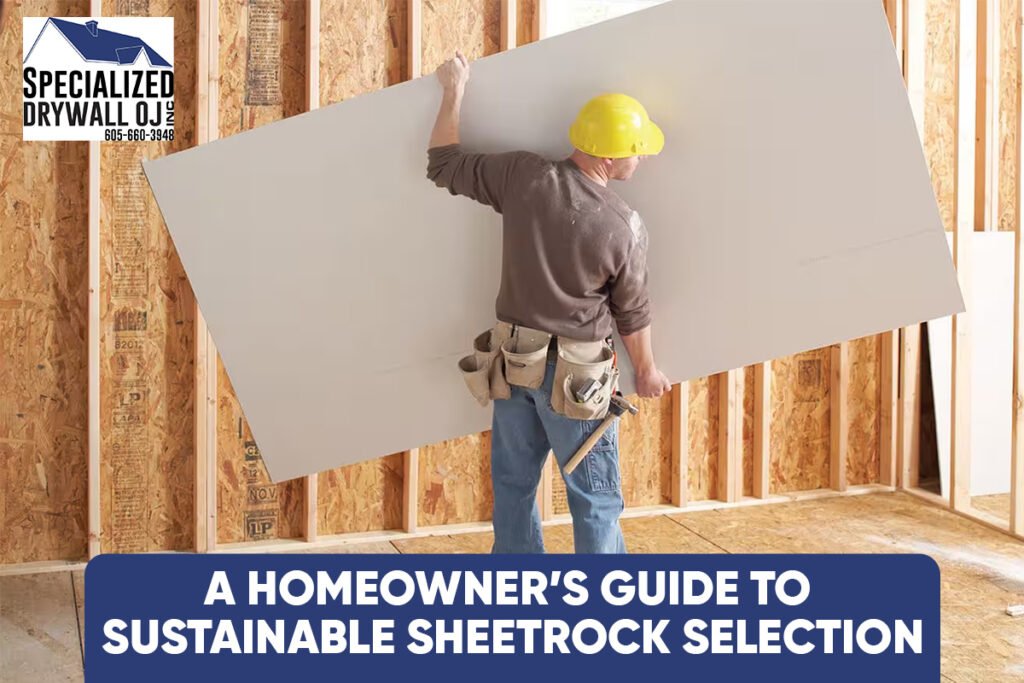Sustainability isn’t just a buzzword anymore—it’s a responsibility. As more homeowners take steps toward greener living, every construction choice matters, down to the walls. Sheetrock, or drywall, might seem like a standard building material, but its environmental impact can be significant. Fortunately, there are smarter, more sustainable Sheetrock options out there.
Whether remodeling your home or starting from scratch, choosing eco-friendly drywall helps improve indoor air quality, reduces landfill waste, and supports responsible manufacturing practices. This guide will walk you through everything you need to know about selecting sustainable Sheetrock—from understanding the materials to identifying third-party certifications like GREENGUARD and LEED. Let’s make sure your home isn’t just built to last but built to make a difference.

Why Traditional Drywall Isn’t So Eco-Friendly After All?
It might surprise you, but standard drywall production isn’t the greenest process. Traditional drywall consists of a gypsum core wrapped in paper. While gypsum is abundant, mining it consumes energy and can release pollutants.
Most conventional drywall is
- Manufactured using virgin gypsum.
- Produced with energy-intensive processes.
- Often treated with additives that emit volatile organic compounds (VOCs).
- Not always recyclable or biodegradable.
And once it’s in your home? Standard drywall can off-gas chemicals, especially if it contains formaldehyde-based adhesives. That’s not exactly what you want surrounding your family day and night.
What Makes Sheetrock Sustainable?
So what exactly qualifies as “eco-friendly drywall”? Sustainable Sheetrock options generally meet several key criteria:
- Recycled Content:
Look for recycled gypsum drywall. Some brands use synthetic gypsum, a byproduct of industrial processes like flue-gas desulfurization, which diverts waste from landfills.
- Low-VOC or No-VOC:
VOCs can impact indoor air quality. Low-VOC drywall is designed to limit the release of these harmful chemicals.
- Formaldehyde-Free Materials:
Opt for formaldehyde-free drywall to reduce health risks, especially in airtight or well-insulated homes.
- Moisture-Resistant and Mold-Resistant:
Sustainable doesn’t mean flimsy. Many moisture-resistant, sustainable drywall options prevent mold growth—ideal for kitchens, bathrooms, and basements.
- Third-Party Certifications:
Always check for GREENGUARD-certified drywall or LEED-certified drywall options. These give you peace of mind that the product meets rigorous environmental standards.
By choosing sustainable gypsum board, you’re investing in materials that perform well and are gentler on both people and the planet.
Top Eco-Friendly Drywall Types You Should Know
Sustainability comes in many forms. Let’s explore the best types of eco-friendly drywall currently available and what they’re best used for.
1. Recycled Gypsum Drywall
This type uses reclaimed gypsum from manufacturing waste or post-consumer materials. It’s structurally just as sound as traditional drywall but reduces environmental strain by minimizing virgin material usage.
2. Low-VOC Drywall
Perfect for those sensitive to chemicals or with allergies. Low-VOC drywall helps maintain better air quality and is an essential feature in sustainable construction.
3. Formaldehyde-Free Drywall
Even trace amounts of formaldehyde can cause irritation and health issues. Fortunately, many modern drywall manufacturers have eliminated this from their formulas.
4. GREENGUARD Certified Drywall
When you see this certification, it means the drywall has passed stringent testing for low chemical emissions. Ideal for LEED projects and homes focused on health-conscious living.
5. Greenboard Drywall
Often used in moisture-prone areas, greenboard drywall includes a water-resistant core. While not mold-proof, it is mold-resistant and a better option than standard drywall in humid zones.
6. Sustainable Gypsum Board (LEED Certified)
If you’re aiming for LEED points in your build or remodel, selecting LEED-certified drywall contributes directly to your certification goals.
These options are becoming more widely available and affordable, making it easier than ever to build responsibly.
How to Choose the Right Sustainable Drywall for Your Home?
Not every room has the same needs, so you don’t need a one-size-fits-all solution. Here’s how to make smart, sustainable choices room by room.
- Living Rooms & Bedrooms: Prioritize low-VOC and formaldehyde-free drywall for healthier air.
- Bathrooms & Kitchens: Go for moisture-resistant, sustainable drywall or greenboard to reduce mold risks.
- Basements & Garages: These areas can get damp, so moisture resistance and durability are key.
- Ceilings & High-Humidity Areas: Choose reinforced drywall types that resist sagging and mildew.
Also, consider availability in your local area. Working with local suppliers cuts down on transportation emissions. You can explore Specialized Drywall’s Sheetrock Services to see what’s offered near you.
Understanding Certifications: LEED, GREENGUARD & Beyond
Certifications help cut through the marketing jargon. Here’s a quick breakdown of what to look for:
GREENGUARD Certification:
Verifies that the product has low chemical emissions and is safe for indoor environments, especially schools and healthcare settings.
LEED Certification (Leadership in Energy and Environmental Design):
While not for the drywall itself, choosing LEED-compliant materials contributes to points toward your building or remodeling project’s certification.
UL Environment Certification:
Similar to GREENGUARD, this certification verifies sustainability and safety.
Be cautious of “greenwashing.” Always double-check that the certifications are valid and from trusted organizations.
Pro Tips for Installation and Maintenance
Choosing sustainable drywall is only half the job. Make sure your eco-efforts don’t go to waste with poor installation or maintenance.
Installation Tips:
- Work with contractors experienced in green building methods.
- Use low-VOC joint compounds and adhesives.
- Minimize cutting to reduce waste.
- Recycle leftover drywall when possible.
Maintenance Tips:
- Regularly inspect for moisture buildup behind walls.
- Repair cracks quickly to prevent mold issues.
- Clean using mild, non-toxic cleaners.
Check out How to Repair Sheetrock Walls—Essential Tips if you ever need to patch or maintain your sustainable drywall.
Final Thoughts: Build Smart, Live Healthier
Choosing sustainable Sheetrock isn’t just about being environmentally responsible—it’s about creating a healthier, more durable home for you and your family. From recycled gypsum drywall to formaldehyde-free and low-VOC options, there are plenty of choices that align with your values without sacrificing performance or aesthetics.
If you’re ready to make the switch, reach out to local professionals like Specialized Drywall OJ Inc. to learn about installation, service options, and available eco-materials in your area.
FAQs About Sustainable Sheetrock Selection
Q: What is the most eco-friendly type of drywall?
A: Recycled gypsum drywall and certified drywall are among the most eco-conscious choices due to their low emissions and use of reclaimed materials.
Q: Can I recycle drywall scraps?
A: Yes. Many areas have facilities that accept clean, drywall scraps. Be sure to keep it separate from other waste to prevent contamination.
Q: Is greenboard drywall mold-proof?
A: Not entirely. Greenboard is mold-resistant but not mold-proof. For areas with high humidity, moisture-resistant, sustainable drywall with mold-inhibiting additives is better.
Q: Does sustainable drywall cost more than traditional drywall?
A: Typical, yes, but only slightly. The health, durability, and environmental benefits often outweigh the added cost.
Q: Can sustainable drywall be used in commercial spaces?
A: Absolutely, GREENGUARD and LEED certifications are often required in commercial projects aiming for sustainability goals.


One Response